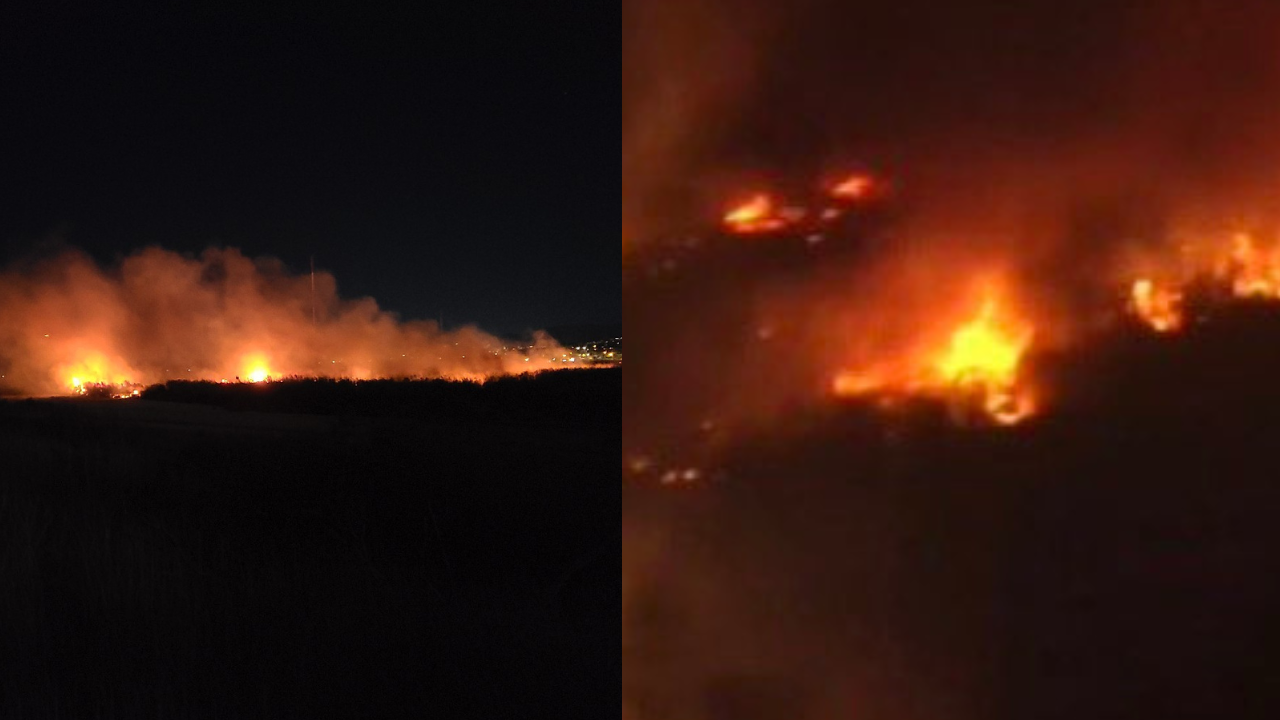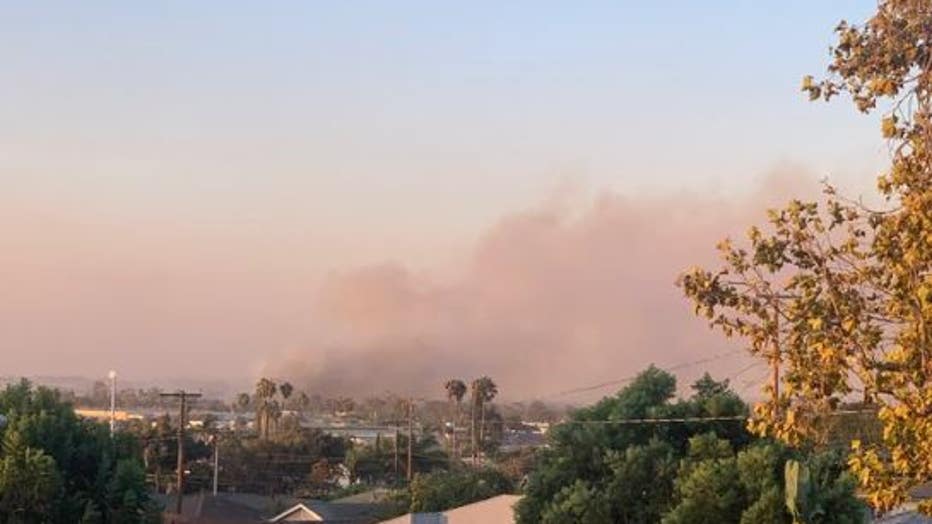Oxnard Fire Updates: What You Need To Know Now!
Is Oxnard, California, facing a reckoning with its past, a present defined by peril, and a future inextricably linked to the destructive power of fire? The recent events, a stark reminder of the vulnerability of communities and the relentless forces of nature, demand our immediate and unwavering attention.
The city, a tapestry woven with threads of agricultural prosperity, coastal beauty, and a burgeoning population, finds itself at a critical juncture. The specter of wildfires, once a distant threat, now looms large, casting a long shadow over daily life. From the sprawling farmlands that feed the nation to the residential neighborhoods nestled near the Pacific, the risk is palpable, a constant undercurrent of anxiety for residents and emergency responders alike. The term "fire Oxnard" has become more than a simple geographical descriptor; it's a symbol of challenge, resilience, and the urgent need for proactive measures.
The history of Oxnard is deeply intertwined with the land. The fertile soil of the Oxnard Plain has been the lifeblood of the region, attracting farmers and laborers seeking to cultivate a bounty of crops. However, this prosperity has also created a unique set of challenges. The dry summers, coupled with prevailing winds, transform the grasslands and brush into tinderboxes, ready to ignite at the slightest spark. The proximity of the Santa Monica Mountains, with their dense vegetation, further increases the threat, acting as a conduit for flames propelled by the notorious Santa Ana winds.
Recent fires have served as a brutal wake-up call. They have exposed vulnerabilities in infrastructure, stretched the resources of first responders, and forced residents to confront the reality that their homes and livelihoods are constantly at risk. The stories of those who have lost everything, the heroic efforts of firefighters battling the inferno, and the collective spirit of a community struggling to rebuild are etched in the city's collective memory.
The economic impact is also significant. Beyond the immediate devastation of property loss, wildfires disrupt agricultural production, impacting the supply chain and contributing to higher food prices. The tourism industry, another vital component of Oxnard's economy, can suffer as a result of evacuation orders and the perception of risk. The long-term consequences, including the erosion of the tax base and the need for costly recovery efforts, pose a serious threat to the city's financial stability.
In response, Oxnard has intensified its efforts to mitigate the risks. Fire departments are implementing enhanced prevention programs, including prescribed burns to reduce fuel loads and public education campaigns to promote fire safety awareness. City officials are working to improve evacuation routes, strengthen building codes, and invest in the latest firefighting technology. These measures are crucial, but they are only a part of the solution.
The challenge of fire in Oxnard is not solely a local issue. It is a symptom of broader environmental changes, including rising temperatures and altered precipitation patterns, that are fueling more frequent and intense wildfires across the state. Addressing the root causes of this crisis requires a comprehensive approach that includes climate change mitigation, sustainable land management practices, and regional collaboration. The very fabric of life in Oxnard, and in communities across the state, is intimately connected to how we respond to this evolving threat.
The battle against fire in Oxnard is a long and arduous one. It requires constant vigilance, unwavering commitment, and a spirit of unity. The resilience of the community, the dedication of first responders, and the proactive efforts of city officials offer a glimmer of hope. The future of Oxnard hinges on the ability to learn from past tragedies, adapt to the changing realities of climate change, and build a safer, more sustainable future for all.
Consider, for a moment, the individual stories that intertwine with the larger narrative of "fire Oxnard." People's lives, their histories, and their contributions to the community form the very essence of the city. To understand the full scope of this phenomenon, it's important to consider the human impact.
| Bio Data of [Hypothetical Person - Example: Firefighter Ava Rodriguez] | |
|---|---|
| Name | Ava Rodriguez |
| Date of Birth | July 12, 1985 |
| Place of Birth | Oxnard, CA |
| Marital Status | Married |
| Children | 2 |
| Education | Oxnard High School, Associate Degree in Fire Science |
| Current Residence | Oxnard, CA |
| Career & Professional Information | |
| Profession | Firefighter |
| Years of Experience | 15 years |
| Employer | Oxnard Fire Department |
| Rank | Captain |
| Specializations | Wildland Firefighting, Hazardous Materials Response, Search and Rescue |
| Awards & Recognition | Oxnard Fire Department Medal of Valor (2018), Ventura County Firefighter of the Year (2021) |
| Significant Contributions | Led several successful fire suppression efforts, mentored numerous junior firefighters, developed and implemented community fire safety programs. |
| Professional Affiliations | California Professional Firefighters |
| Hobbies & Interests | Hiking, reading, spending time with family, volunteering in the community |
| Reference: Example - (Replace with an actual, relevant website if available; e.g., the Oxnard Fire Department website or a news article about a firefighter.) |
The narrative of fire in Oxnard, especially within the context of ongoing climate changes, can also encompass various aspects of disaster management and risk mitigation. These factors are key elements in shaping how communities adapt and respond to such threats. For instance, the creation of evacuation strategies, improvements in urban planning, the utilization of modern technologies like satellite imaging, and the establishment of robust communication networks all contribute significantly to building a more resilient city. Therefore, it is vital to examine the multifaceted strategies put into place by the local government and concerned communities to lessen the impact of wildfires.
The challenge of safeguarding Oxnard from wildfires is multi-layered, stretching from local fire stations to state-level regulations and initiatives. The ability of the city to prepare for and handle fire emergencies hinges on several essential aspects. This includes the effectiveness of fire suppression tools and techniques, the integration of state-of-the-art surveillance systems, and the availability of sufficient resources for battling wildfires, which are all critical to mitigating risks. Furthermore, the promotion of community awareness and proactive measures, like fire-resistant building codes and routine brush clearing, also play vital roles in reducing the severity of these incidents.
The financial ramifications of wildfires are extensive, encompassing property damage, the loss of crops, and the costs of recovery operations. These expenses may seriously affect Oxnard's budget, necessitating funding from multiple sources. In turn, a need for financial sustainability and effective resource management arises. Therefore, a comprehensive assessment of the financial burden of wildfires, as well as the creation of financial plans for disaster relief, is vital to guarantee the long-term stability of the city.
Looking forward, the path to a more secure future for Oxnard requires a proactive and integrated approach. This strategy involves continuous monitoring and risk evaluation, the deployment of up-to-date fire suppression tools and technology, and the use of data analytics to enhance preventative measures. In addition, the involvement of the community and ongoing public education efforts are vital. This proactive strategy is aimed at constructing a resilient Oxnard, capable of facing future fire hazards with resolve and expertise.
To further illustrate the breadth of the problem, let's examine several factors within Oxnard's situation using a structured table:
| Oxnard Fire Risk: Key Aspects and Strategies | |
|---|---|
| Risk Factor | Mitigation Strategies |
| Dry vegetation and high fuel loads | Prescribed burns, vegetation management programs, fuel reduction projects in wildland-urban interface (WUI) areas. |
| Santa Ana winds | Enhanced weather monitoring, early warning systems, proactive fire weather forecasting, and increased readiness during high-wind events. |
| Climate change (rising temperatures and altered precipitation) | Advocating for climate action, supporting regional and state climate resilience initiatives, promoting sustainable land management practices. |
| Aging infrastructure and building standards | Updating building codes to include fire-resistant materials, improving evacuation routes, and strengthening infrastructure (water supply, communication systems). |
| Community preparedness and awareness | Public education campaigns, fire safety workshops, encouraging residents to create defensible space around their homes, promoting the Ready, Set, Go! program. |
| Limited resources for firefighting | Investing in new firefighting equipment (aircraft, engines), increasing firefighter training and staffing, and establishing mutual aid agreements with neighboring fire departments. |
| Agricultural land and practices | Implementing fire-safe agricultural practices (e.g., controlled burns, vegetation management along property lines), coordinating with agricultural stakeholders. |
| Economic impacts | Developing economic recovery plans, supporting businesses affected by wildfires, exploring insurance options, and seeking federal and state disaster assistance. |
| Evacuation challenges | Improving evacuation planning and routes, establishing clear communication protocols, conducting regular evacuation drills, and identifying vulnerable populations. |
The issue of fire within Oxnard shows the interconnectedness of environmental, societal, and economic elements. As the area deals with the constant threat of wildfires, its crucial to take an all-encompassing approach that tackles both the underlying drivers of the problem and the immediate hazards. By embracing strategic planning, the people of Oxnard can not only defend themselves but also cultivate a more resilient community, equipped to confront the unpredictable challenges of the future.
The efforts to decrease the risk of fire should go hand in hand with a larger emphasis on long-term ecological health. The management of the land, the use of water resources, and the preservation of natural habitats all affect the chance of wildfires. By emphasizing sustainable approaches to land use and supporting policies that protect ecosystems, Oxnard can foster its natural defenses, improving its chances of withstanding the impacts of climate change and reducing the intensity of wildfires.
The evolution of "fire Oxnard" is a narrative of both destruction and endurance. As Oxnard fights to safeguard its citizens and their way of life, the city is faced with a tough balancing act. The decisions made today, the investments in the future, and the dedication to fostering a collaborative spirit will decide the fate of this coastal city. It is a chance to reconstruct, improve, and create a future that is both secure and resilient, a future where the narrative of "fire Oxnard" is transformed from one of destruction into one of triumph.




